|
|
Post by Reptisaurus! on Mar 17, 2019 21:15:31 GMT -5
JMS pulls a page from Alan Moore’s gamebook, OH MY GOD!!! SAY IT ISN'T SO! How is this possible?!?!?!?! My mind is blown! Is... is the sun going to rise in the east?!?! WILL WATER CONTINUE TO BE WET?!?!?! I think I liked this series ok, but I don't remember anything about the plot. So these reviews are really interesting. I'm a little curious if his tv work had more than one influence, though. Everything he did in comic was just so... so... so... second rate Alan. |
|
|
|
Post by rberman on Mar 17, 2019 21:27:12 GMT -5
JMS pulls a page from Alan Moore’s gamebook, OH MY GOD!!! SAY IT ISN'T SO! How is this possible?!?!?!?! My mind is blown! Is... is the sun going to rise in the east?!?! WILL WATER CONTINUE TO BE WET?!?!?! I think I liked this series ok, but I don't remember anything about the plot. So these reviews are really interesting. I'm a little curious if his tv work had more than one influence, though. Everything he did in comic was just so... so... so... second rate Alan. Well, the list of comic book creators who built upon Moore includes pretty much everyone writing for Marvel, DC, and Image after 1986, so... Being "second rate Alan Moore" sounds more like an aspiration than a criticism. Compared to most comic books, JMS is practically Shakespeare. As was mentioned, his TV show Babylon 5 drew substantially upon E.E. "Doc" Smith's Lensman series. Also Alfred Bester's The Demolished Man, Tolkien, Lovecraft, and Walter Miller's A Canticle for Liebowitz, to name a few. |
|
|
|
Post by Reptisaurus! on Mar 17, 2019 22:12:06 GMT -5
OH MY GOD!!! SAY IT ISN'T SO! How is this possible?!?!?!?! My mind is blown! Is... is the sun going to rise in the east?!?! WILL WATER CONTINUE TO BE WET?!?!?! I think I liked this series ok, but I don't remember anything about the plot. So these reviews are really interesting. I'm a little curious if his tv work had more than one influence, though. Everything he did in comic was just so... so... so... second rate Alan. Well, the list of comic book creators who built upon Moore includes pretty much everyone writing for Marvel, DC, and Image after 1986, so... Being "second rate Alan Moore" sounds more like an aspiration than a criticism. Compared to most comic books, JMS is practically Shakespeare. As was mentioned, his TV show Babylon 5 drew substantially upon E.E. "Doc" Smith's Lensman series. Also Alfred Bester's The Demolished Man, Tolkien, Lovecraft, and Walter Miller's A Canticle for Liebowitz, to name a few. There are, honestly, no other writers in mainstream comics ever (that I can think of) that borrowed from Alan Moore (in general and Watchmen in particular!) so specifically and exclusively. That's not 100% an insult - Moore is IMO one of the top two most formally skilled writers to work in American factory system comics - but not exactly a compliment. I liked the first few issues of Rising Stars but honestly don't find the rest of his stuff that memorable. I have heard good things about Babylon Five, though! I'm not a super huge TV guy so I'll probably never get around to watching it (I have, like, 100 hours of Marvel Netflix shows to get through) but that is a cool set of influences! |
|
|
|
Post by codystarbuck on Mar 17, 2019 23:21:23 GMT -5
Babylon 5 was a novel for television. There is a beginning middle and end and it is structured like a novel. The characters grow and change across the series; with the initial seasons villains and sympathetic characters even swapping places, sort of. JMS wrote about 90% of the series. He wrote most of seasons 1 and 2 (the key arc episodes, especially) and then wrote everything from seasons 3-5, except for Neil Gaiman's "Day of the Dead," in Season 5. Harlan Ellison was supposed to write an episode; but wasn't able to finish the script.
It really was good television, with a tremendous and epic story. From EE Smith, he borrowed the advanced alien races that manipulated genetic lines of other races, to develop warriors in a cosmic battle of opposing forces. From The Demolished Man he took the idea of a psychic police force, whose chief agent, played by Walter Koenig, was named Bester, after the author. From Tolkien there were the Rangers, a group of humans and aliens who watch the movements of the Shadows and act as intergalactic peace agents, in later storylines (borrowing from the Galactic Patrol, of Smith, of whom, the Lensmen are the elite). The character of Lorien is also very Tolkien, as are some others. There are nods to Roman history, via the Centauria, especially the mad Emperor Cartagia, who is a parallel to Caligula. There are parallels to fascism, in WW2, with the rise of Pres. Clark and his nightwatch, a sort of gestapo. At one point, Babylon 5 breaks from the Earth Alliance, in response to attacks on civilian populations in breakaway colonies. They become a base to launch a counter-revolution against the repressive Clark government, which resulted in some spectacular space battles (as did the latter stages of the Shadow War).
If the series has a weakness, it is in season 5, which was affected by some storylines being folded into season 4, when it looked like season 5 wouldn't happen. There are also weak segments in the first season, as they are developing the characters and kind of get caught in the stereotypical weekly plot cycle. When they focused on the season arc, it is terrific, and some episodes pai off later, down the line.
There is some dodgy acting; but not from the actors playing the alien ambassadors. Andreas Katsulas had amazing scenes that he never got to do, outside of make-up (he was the One-Armed Man, in the Fugitive movie, with Harrison Ford). Peter Jurasik gets to play comedy, drama and tragedy. Stephen Furst got to show some of the same stuff he did in St Elsewhere. Walter Koenig got to demonstrate that Trek never really knew how to use his strengths, as an actor (or George Takei, or Nichelle Nichols, or James Doohan).
For a tv budget, they really put it all on screen and showed up Star Trek, at every turn. JMS' writing was brilliant, though he had a couple of clunkers, written while under the influence of severe illness.
I'm not big on Rising Star; for one thing, until Brent Anderson came on as artist, it had that awful, over rendered Image style. the characters were a bit cliched, too. JMS had ideas; but, I think he executes them far better here and in The Twelve. Supreme Power/Squadron Supreme had some interruptions and then he didn't get to finish it, and it ended up in the mess that the Ultimate line became, when they did the crossover, which I will get to, in a bit.
Captain Power, for a low budget syndicated show, designed to sell kids' toys, was actually a rather well written show, that way exceeded the intentions of the people who launched it.
I think JMS' sensibilities are in tune with Moore, rather than aping him, and I see a lot of the same similarities in a lot of the deconstructionist superhero works. there are similar age groups, too, bringing in a lot of the same influences. With Moore, you get a lot of the New Worlds writers and counter culture stuff, mixed with more traditional stuff. JMS crosses over with some of that; but with a stronger line in the American sci-fi community, both the old masters and the New Wave stuff, as seen in Ellison's Dangerous Visions (and he was tight with Ellison).
Personally, I think he is a top level comic writer; but, his work in prose and tv is far superior to his comics stuff. Ellison also rated him highly, if that carries any weight with you. His work also has a sense of humor in it (there are plenty of quick gag bits in Supreme Power, similar to things he did on Babylon 5). He's not quite a Terry Pratchett; but, knows how to write a humorous scene or bit of dialogue, without posting big neon signs on it.
|
|
|
|
Post by codystarbuck on Mar 18, 2019 0:25:09 GMT -5
Supreme Power #4 A little Visine might help that..... Creative Team: No significant changes, other than Mike Raicht is not listed as a co-editor; but is thanked. Synopsis: We open with contrasting images, as Hyperion rescues a disabled small aircraft, setting it down safely, to be gawked at and admired by bystanders and interviewed by reporters. In the other scenes we have his "parents" meeting with Gen Casey, in a shielded underground facility, talking about their extraction. They are to be removed from the home and their deaths faked, so they can go on with their lives, in Amsterdam, under assumed names. the feeling is that it will push Hyperion into seeing the country and government as surrogate parents, further solidifying his relationship with it and increase his loyalty to it. It turns out that the plane emergency was staged to keep Hyperion occupied, while the meeting took place... 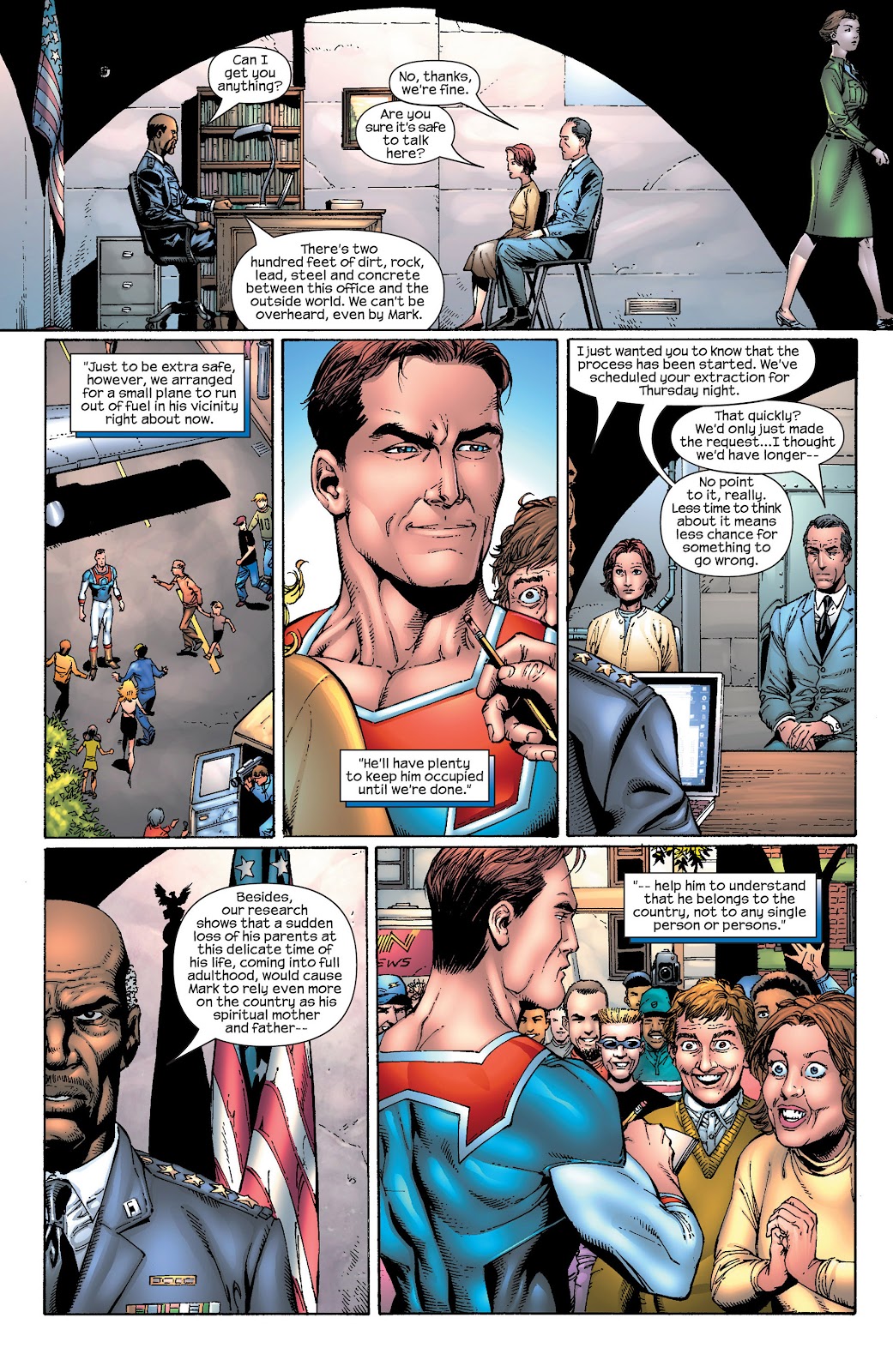 It is one year after Hyperion's public unveiling and Kyle Richmond is informed that he has come into his full inheritance, which has been folded into his holdings. he is less than enthusiastic at hearing this and seems troubled by the news features on Hyperion. he dismisses his aid, with a seemingly hostile attitude, then tries on his new suit, which is not Armani. It features black leather, kevlar and trauma plates, and bird-like goggles, with special optical features. This is the debut of someone else. We cut to an urban horror scene, as an African-American woman flees down an alley, chased by a pack of white, mouth-foaming men. A hand reaches into a pouch and extracts a sharpened object, shaped like an arrowhead, and then throws it at one of the men, imbedding in his eye. The others stop and see the mani in black, in their way. They tell him to get out and he says "No." he then systematically and brutally ends the face off... 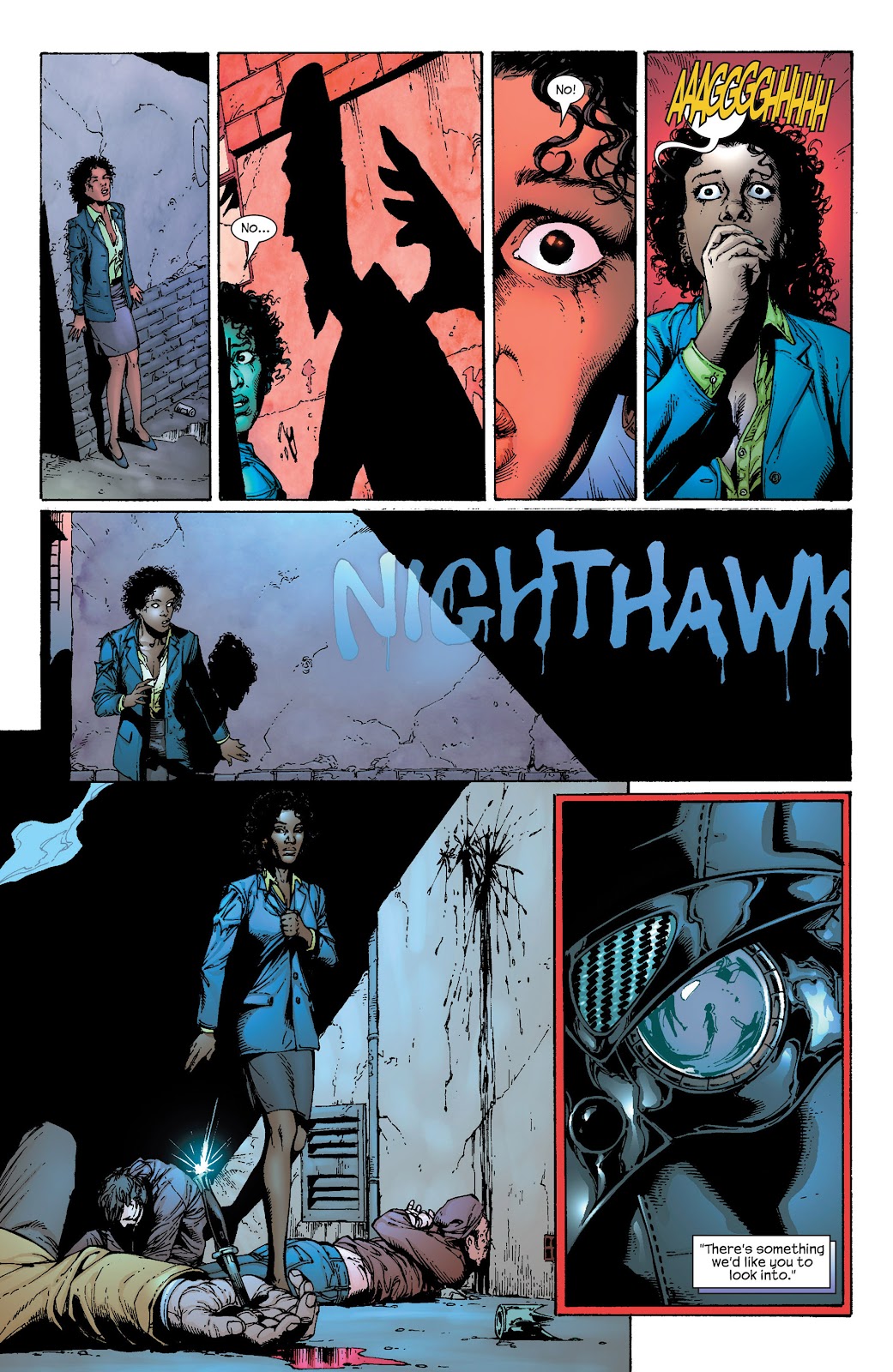 Gen Casey comes to Mark's house to ask him to check out reports of a strange phenomena in Atlanta, the Atlanta Blur. They have photo evidence; but, want to ensure it isn't just pattern recognition (pareidolia), and Mark is the only one that can move at speeds to verify if the blur is something else. His father says they were going fishing; but, Mark agrees to take the mission. As he leaves, he asks his father if he is okay, as his heart is racing. After Mark leaves, the family leaves with Gen Casey, who says the Blur is just a ruse to send Mark far away, to chase an urban legend, while they extract the agents. The imagery of Mark leaving and his expressions make you wonder if he hears this or senses the truth. He arrives in Atlanta and hovers above the city, as people spot him and gawk. Changes in the sky chart the passage of time, as he floats there, eyes closed. Eventually, he hears the sound he was looking for and speeds off, catching up with a running African-American man, the young boy we saw with his dog, in the previous issues. He tells the man he just wants to talk and the man, tears off at a right angle and bursts away. Mark is stunned and says he is not alone. He is interrupted by a military officer, who says something has happened to his parents. Boats are searching off the coast and Hyperion plunges into the water and searches, seeing a boat with a hole ripped into the hull. We end with Mark on the shore, and a plane arriving in Amsterdam... 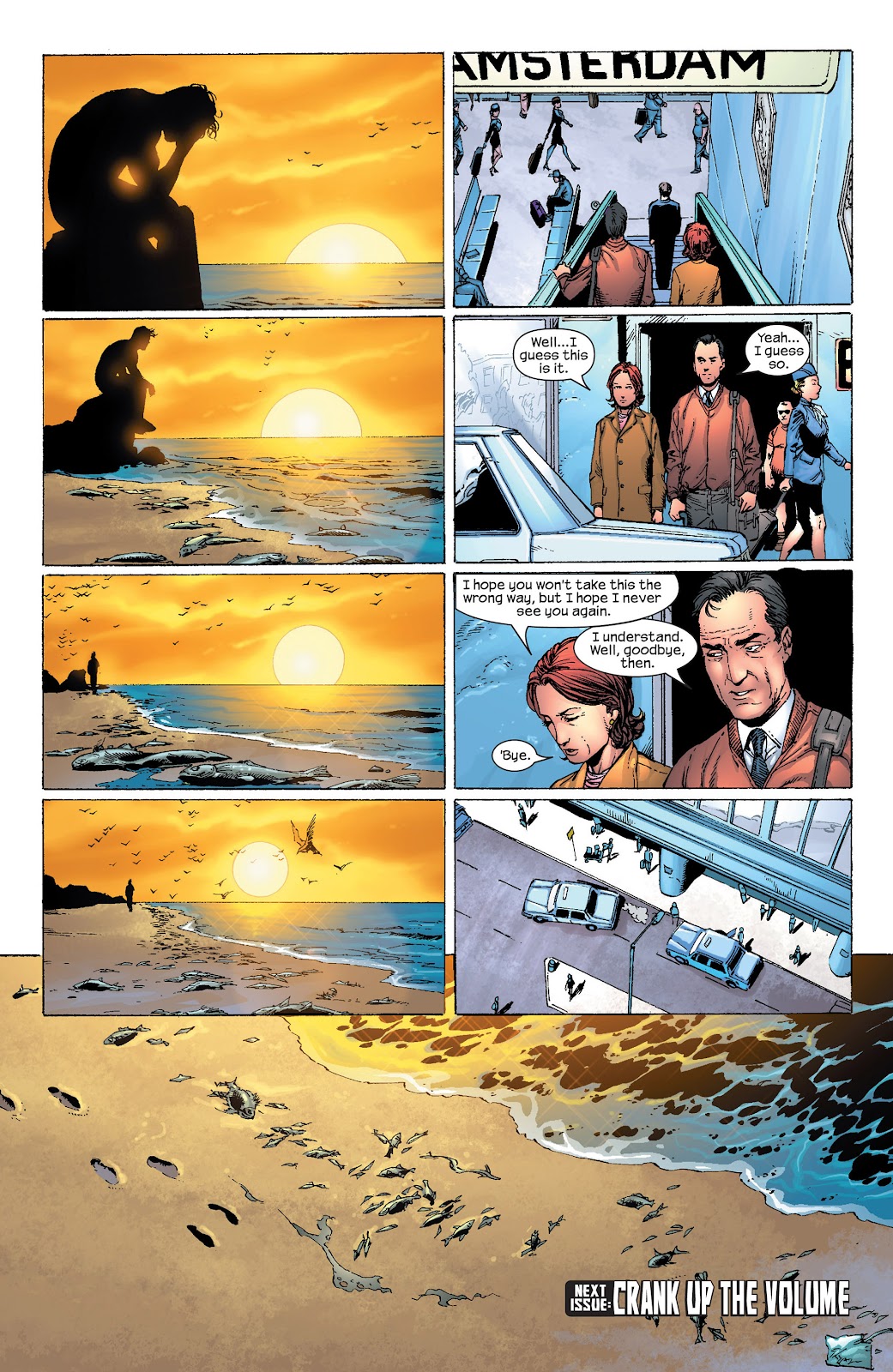 Thoughts: Thoughts: One year later and the world is still enraptured with Hyperion. The agents want out and the government thinks their removal would solidify Mark's connection to the country and the government, as surrogate parents. However, despite the obvious conclusion, JMS lets the agents live. It would seem that someone with Hyperion's abilities could easily track them down, which would make killing them a likely decision. Given what else has gone on in Project: Hyperion, you are surprised that they are let loose. Guess JMS isn't as bloodthirsty as Moore or Morrison. Nighthawk is unveiled and he stops an attack by white men, on an African-American woman, right after referring to the reason for his inheritance, the racially motivated murder of his parents. As we will see, race is a major factor in this Nighthawk's activities. Here again, JMS is throwing a wrench into the works, upending our expectations. It's one thing to have a black hero defend people against racists; but, his hero is soon shown to be selective in who he assists. More flaws for these "heroes." He did much the same in babylon 5. In the pilot film ("The Gathering," and in much of season 1, the apparent villain is G'Kar, who years to put his people in a position of power, in the galaxy, years after the liberation of it, from the Centauri Empire. he is a schemer; but, is shown to be a patriot. At one point, he dispatches a rescue of the love interest of the station's captain, a man he framed for attempted murder, in the pilot film. he tells her of the advanced races that exist in remote areas of the galaxy, where she was surveying, and the danger in crossing them. he has nothing to gain from this act. Later, he reacts to an attack by his people. Londo, the centauri ambassador, is a fool and a drunkard, dreaming of past glories, while dealing with the decline of his people's empire. Into this comes Morden, the agent of the Shadows, who questions the ambassadors as to what they want, repeating the question to all. G'Kar wants his people free and safe from future aggression; but, has no designs beyond that, showing that he is not a power mad heel. Londo wants his people returned to their rightful place in the galaxy, a restoration of past glory. he becomes the focus of the Shadows, which brings chaos and destruction to other worlds, which improves Londo's stature at home, bringing him into contact with powerful conservative forces, who want to reverse the policies of the current emperor. he becomes complicit in the emperor's murder (though he has no direct knowledge of the plot, then the attack on the Narn homeworld, with Shadow aid. G'Kar becomes a freedom fighter and voice of liberty to his people and others, while Londo sounds like a fascist mouthpiece, reversing their positions. Later in the series, they become wary allies and even friends, after a fashion. JMS likes his flawed characters, showing their heroic sides and their cowardly. No character is black & white. Ditko would hate his work. (or, at least, his character's facets). Gary Frank repeats his odd images of wide-eyed characters, showing that the girl in Mark's school wasn't a weird design choice; but, a flaw in his art. He does the same with a crowd of admirers, showing their eyeballs nearly bursting from their sockets, while all but devoid of eyelids and lashes. You can see it in the first sample, above, and when Hyperion shows up, in Atlanta. It is a facial expression that seems to be outside of Frank's reach. Also, if you look at his women, they are stick figure thin, in the younger cases. This will be especially true of the women we will meet in the Squadron. That may be a concession to models and actresses of the period (and today) and the anorexic look or just that Frank likes his women thin. Artists tend to draw a lot of the same body types, in comics. More often than not, they fit within the artists tastes towards human features. Jim Balent liked large breasts, as did Corben, while Frazetta seemed to like a curvy behind. Chaykin seemed to like his women classically proportioned, in stylish clothes, stiletto heels and 40s lingerie. The Image guys seemed to prefer them with large breasts, double jointed, and without feet. Dave Sim likes them in the 1800s, when they were subservient.  Nighthawk's suit was showcased in the sketchbook, seen in the special edition of issue #1. A lot of detail went into a protective and functional suit, which still has bird elements. it's a big improvement over the Marvel Universe Nighthawk, in any version. We are still introducing characters and having them come in contact, while continuing the world building. JMS is still in his introductory phase of the story, before coming to the rising conflict. He is definitely playing a long game, here. To a certain extent, hedoes follow the six-issue arc structure; but, he doesn't necessarily follow it rigidly. We do still see more introduction in the issue that follow #6; but, we also see the start of the rising conflict. JMS akes concession to the publishing demands of modern comics, to fit the trade length; but, he doesn't suddenly wrap things up, like some works out there. He doesn't dangle threads for as long as Claremont; but, then again, he still had a day job.
|
|
|
|
Post by berkley on Mar 18, 2019 0:30:19 GMT -5
I liked Babylon 5 back in the day but could never drum up any interest in JMS's comics work. Nothing I ever saw in previews or online samples ever impressed me favourably - I felt a strong distaste for the entire premise of his Thor, for example. And yes, most of it did feel very derivative, coming years after Moore's 80s stuff.
|
|
|
|
Post by codystarbuck on Mar 18, 2019 0:49:55 GMT -5
I liked Babylon 5 back in the day but could never drum up any interest in JMS's comics work. Nothing I ever saw in previews or online samples ever impressed me favourably - I felt a strong distaste for the entire premise of his Thor, for example. And yes, most of it did feel very derivative, coming years after Moore's 80s stuff. I didn't read Thor; but, I liked this stuff, until his abrupt departure, and The Twelve, until it stalled. I still haven't read the ending, though I have the material. I'm not much in awe of Kevin Smith's superhero stuff. it's fine; but not spectacular and I thought Daredevil was a bit over-rated; but, that's me. I much more enjoyed his work on his own characters. Same with Bendis. His superhero stuff ranged from fine to not interested, while I greatly enjoyed his crime fiction. Chaykin is another who is on a higher plane, when he works on his own material, though he had excellent stories with company properties, like his Batman Elseworlds (Dark Allegiance, Batman & Houdini, Thrillkiller). |
|
|
|
Post by zaku on Mar 18, 2019 2:17:26 GMT -5
Gen Casey comes to Mark's house to ask him to check out reports of a strange phenomena in Atlanta, the Atlanta Blur. They have photo evidence; but, want to ensure it isn't just pattern recognition (pareidolia), and Mark is the only one that can move at speeds to verify if the blur is something else. His father says they were going fishing; but, Mark agrees to take the mission. As he leaves, he asks his father if he is okay, as his heart is racing. After Mark leaves, the family leaves with Gen Casey, who says the Blur is just a ruse to send Mark far away, to chase an urban legend, while they extract the agents. The imagery of Mark leaving and his expressions make you wonder if he hears this or senses the truth. He arrives in Atlanta and hovers above the city, as people spot him and gawk. Changes in the sky chart the passage of time, as he floats there, eyes closed. Eventually, he hears the sound he was looking for and speeds off, catching up with a running African-American man, the young boy we saw with his dog, in the previous issues. He tells the man he just wants to talk and the man, tears off at a right angle and bursts away. Mark is stunned and says he is not alone. He is interrupted by a military officer, who says something has happened to his parents. Boats are searching off the coast and Hyperion plunges into the water and searches, seeing a boat with a hole ripped into the hull. We end with Mark on the shore, and a plane arriving in Amsterdam...  I remember when I read this story I thought: "How is possible that he isn't suspecting anything? Bodies don't evaporate! And this is a lake, it's not like the currents brings them to the open sea!" |
|
|
|
Post by rberman on Mar 18, 2019 5:07:10 GMT -5
Supreme Power #4
My Two Cents: Behold the benefit of a story set in its own continuity: You can say “A year passed since last issue” without falling out of step with the rest of the line. Nighthawk now get his character development spotlight issue. It’s pretty self-explanatory. His penchant for only rescuing minorities being attacked by whites recalls Astro City, in which Winged Victory only rescues women being attacked by men.  The main movement on Mark Milton’s story is the faked death of his parents. A lot is going unsaid here, but the facial expressions lead us to believe that he knows he’s being played with. He is often shown looking way from the people he’s talking to, as if he’s listening to conversations far away. In this panel, he is presumably listening to the discussion about the faking of his parents' death.  It’s also another example of Gary Frank’s weird bug-eyed people.
|
|
|
|
Post by codystarbuck on Mar 18, 2019 12:18:16 GMT -5
You do get a strong sense in the early issues that Mark is far more powerful than he has revealed and he is far more aware of what is going on than his watcher's know. There is a definite cat and mouse there. You'd have to think, based on the Superman model, he can pick up sound waves from a great distance. Even underground, in a shielded facility, there would need to be ventilation, which would allow sound to carry. Mark's hearing may be accute enough that he can pick it up. Later, when he listens for the Atlanta Blur, you really get a sense of how developed his hearing is. We've already seen his augmented vision capabilities and you also suspect that his brain processes information rapidly, which makes the psychological profiles of the watchers suspect. Profiling often has built in flaws, due to biases of the observer and much of the theory is based on human behavior. As we know, Mark isn't human. We have no real idea how quickly his cognitive skills developed.
In many ways, this is the closest Hyperion has been to being a Superman analogue, with the twist of being found and raised by the government, to become a weapon. They see him as the Dark Knight-depicted Superman, an agent and living weapon for America. He sees himself as someone who can do amazing things and wants to help others; but, feels isolated and can sense the fear and anxiety around him.
|
|
|
|
Post by rberman on Mar 18, 2019 12:37:45 GMT -5
You do get a strong sense in the early issues that Mark is far more powerful than he has revealed and he is far more aware of what is going on than his watcher's know. There is a definite cat and mouse there. You'd have to think, based on the Superman model, he can pick up sound waves from a great distance. Even underground, in a shielded facility, there would need to be ventilation, which would allow sound to carry. Mark's hearing may be acute enough that he can pick it up. Later, when he listens for the Atlanta Blur, you really get a sense of how developed his hearing is. We've already seen his augmented vision capabilities and you also suspect that his brain processes information rapidly, which makes the psychological profiles of the watchers suspect. Profiling often has built in flaws, due to biases of the observer and much of the theory is based on human behavior. As we know, Mark isn't human. We have no real idea how quickly his cognitive skills developed. Mark's super-hearing has been called out several times, and his crying while thinking about his parents would seem to indicate that he has uncovered the ruse but is choosing to play along. I haven't read this series in a while, so I don't recall where it all goes.  |
|
|
|
Post by Reptisaurus! on Mar 18, 2019 18:55:42 GMT -5
I liked Babylon 5 back in the day but could never drum up any interest in JMS's comics work. Nothing I ever saw in previews or online samples ever impressed me favourably - I felt a strong distaste for the entire premise of his Thor, for example. And yes, most of it did feel very derivative, coming years after Moore's 80s stuff. Ooh, I forgot about Thor. I really liked his Thor - probably my favorite run since Stan stopped being the regular writer. (The Kirby stuff was the best but I quite enjoyed the Lee/Adams and Lee/Buscema issues that followed right after.) Bringing down to earth and mixing Gods with mortals was inspired and just fun. Thought that was quite a bit stronger than any of his creator owned work. Maybe I will get around to Babylon 5. It's not all THAT many episodes, now that I look. |
|
|
|
Post by codystarbuck on Mar 19, 2019 0:32:29 GMT -5
Supreme Power #5 Kind of surprised DC and Marvel haven't stuck real advertising into the middle of stories. That was starting to occur in prose, as there were nes pieces about advertisers paying for product placement in works of fiction. Creative Team: No additions, though Dan Buckley is listed as publisher and Bill Jemas is not listed as president. The issue is listed as Feb 2004 and that's when it seems that Jemas had burned his bridges at Marvel, between messing with the comics and letting his mouth create ill will in fandom, especially when Marvel couldn't afford to really tick off a shrinking audience. He finally got on the bad side of Avi Arad and Ike Permutter and the writing was on the wall. Synopsis: Mark is in his new penthouse apartment (wait, shouldn't Kyle richmond have the penthouse?), with everything paid by the government. He's feeling a bit constrained and wants to work a normal job, in disguise... 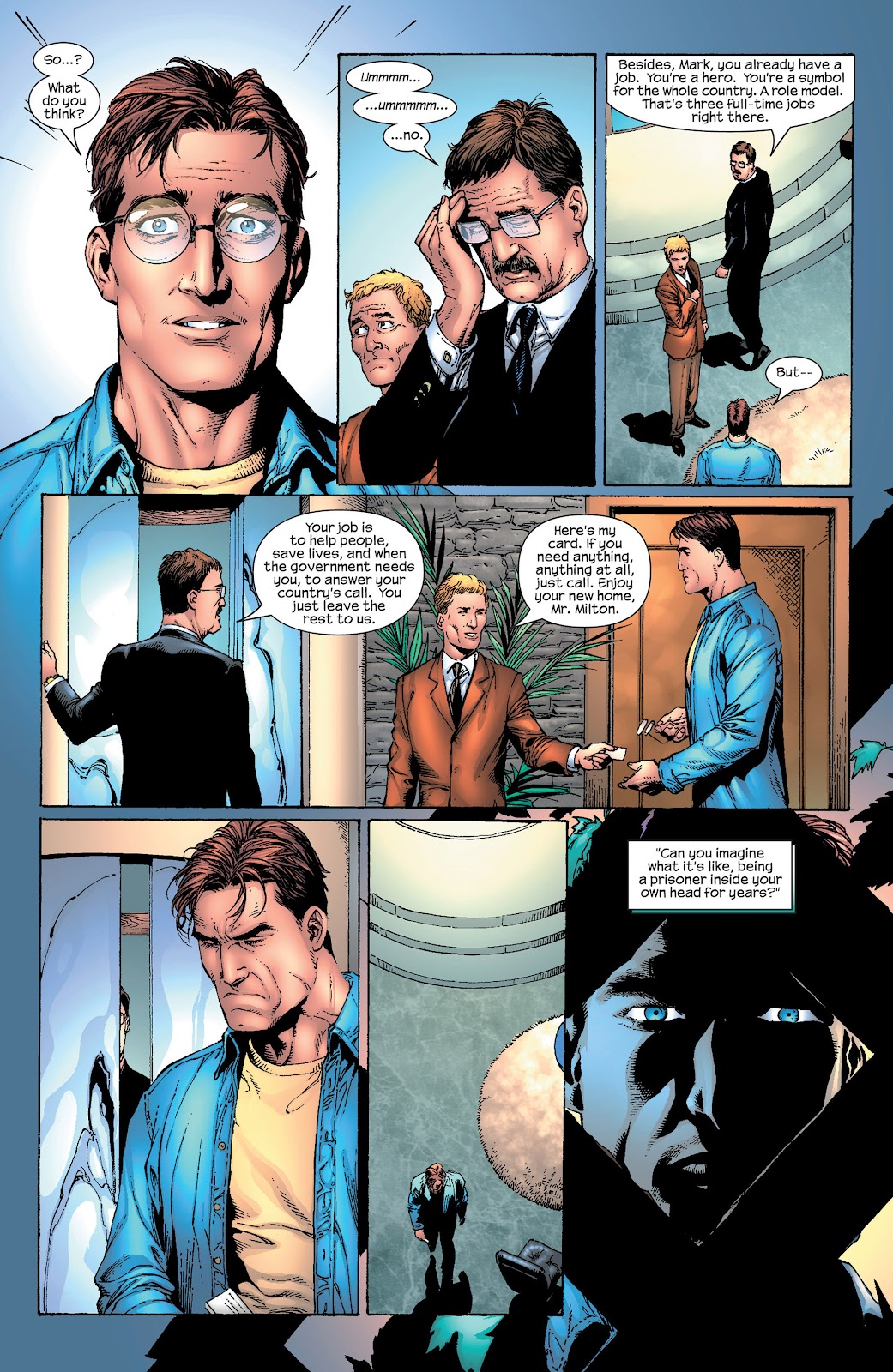 So, I guess crusading reporter at a great metropolitan newspaper is out...... The government men smile at Mark and pat him on the head and tell him not to worry his pretty little head. That isn't going to end well. Joe Ledger's comatose body is being moved to a new location, as a pair of medics swap rumors about the guy. While one checks in with base, the other makes the mistake of touching the prism... 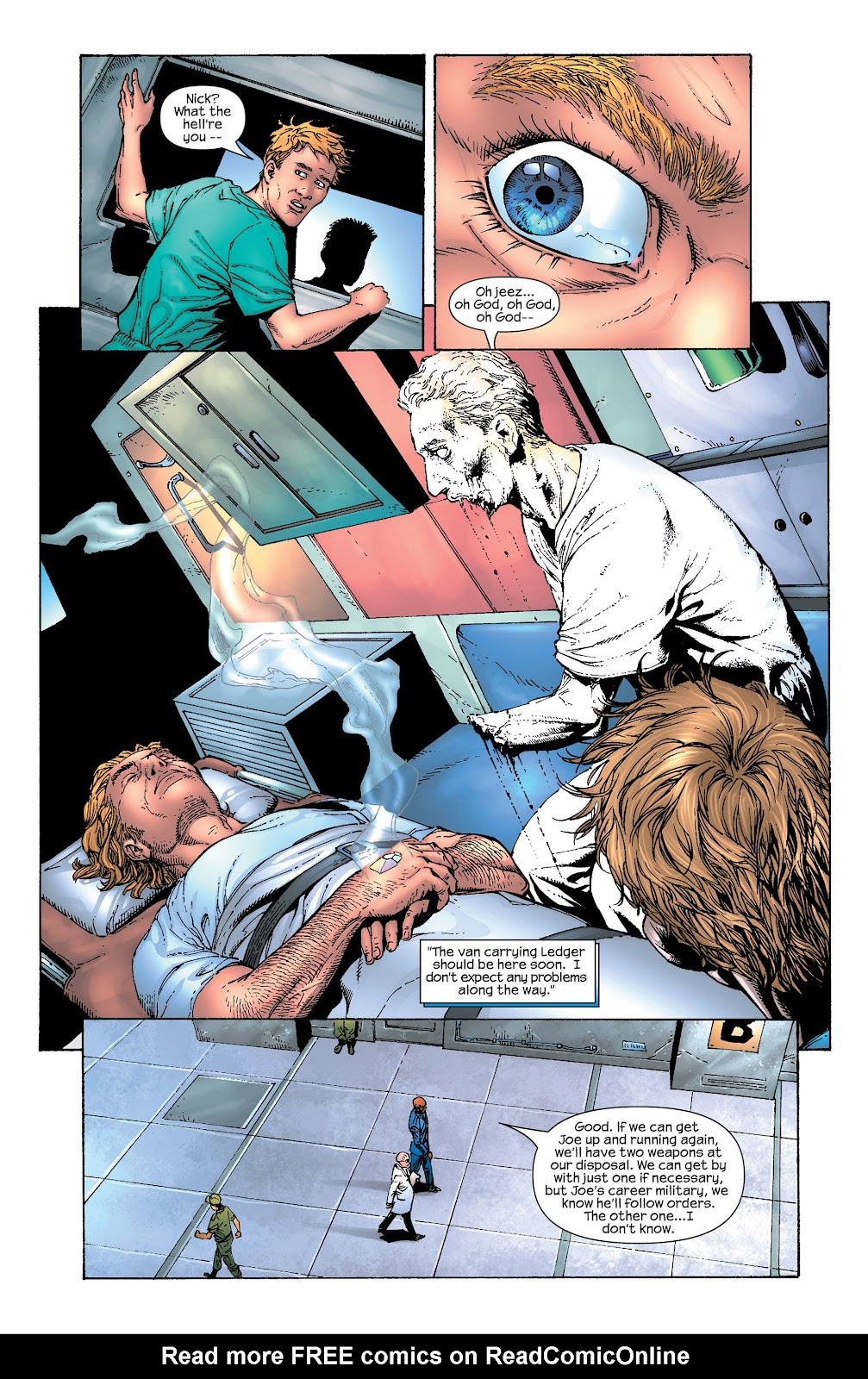 Near Atlanta, a couple of men in black suits come to visit Abigail Stewart, about her son, Stanley. They meet up with the speedster and it turns out they are booking agents, not spooks. They offer Stan all kinds of endorsement deals, based on their evidence that he is the Blur, after setting up high speed cameras in the Atlanta area, which caught Stan. While they were visiting, they noted that, based on trophies, Stan slowed down in competition, suggesting he was intentionally taking a dive to hide his true speed. He wants to be a hero and they say that can make him even richer. Joe Ledger is fed current to try and make him awaken and finally is exposed to the craft that brought Hyperion to Earth, which aakens him, after a fashion... 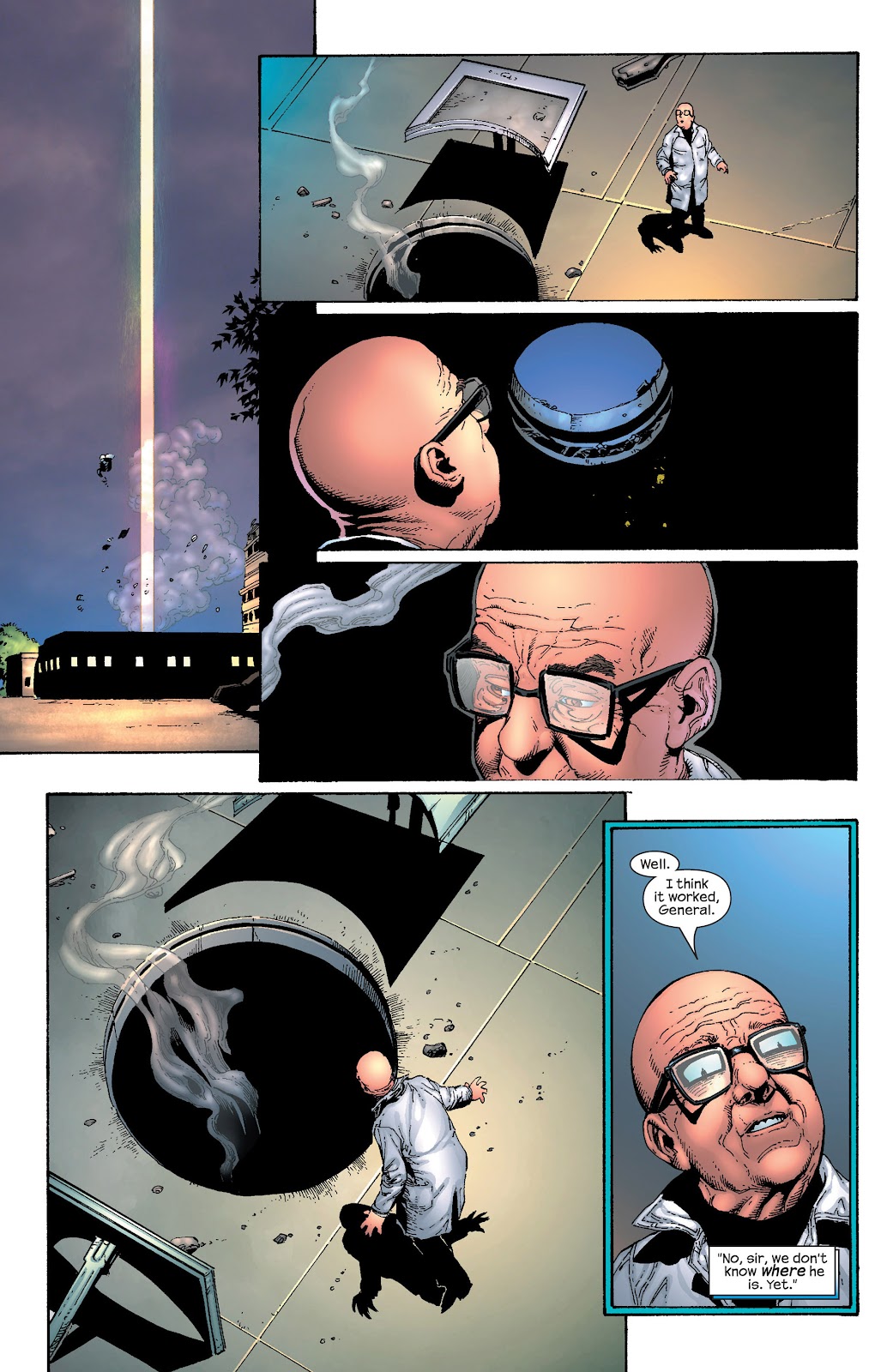 About the same time, the world is introduced to Stan Stewart, aka The Blur and Mark Milton learns he is no longer alone and takes flight. Nighthawk surveys his work, somewhere else... 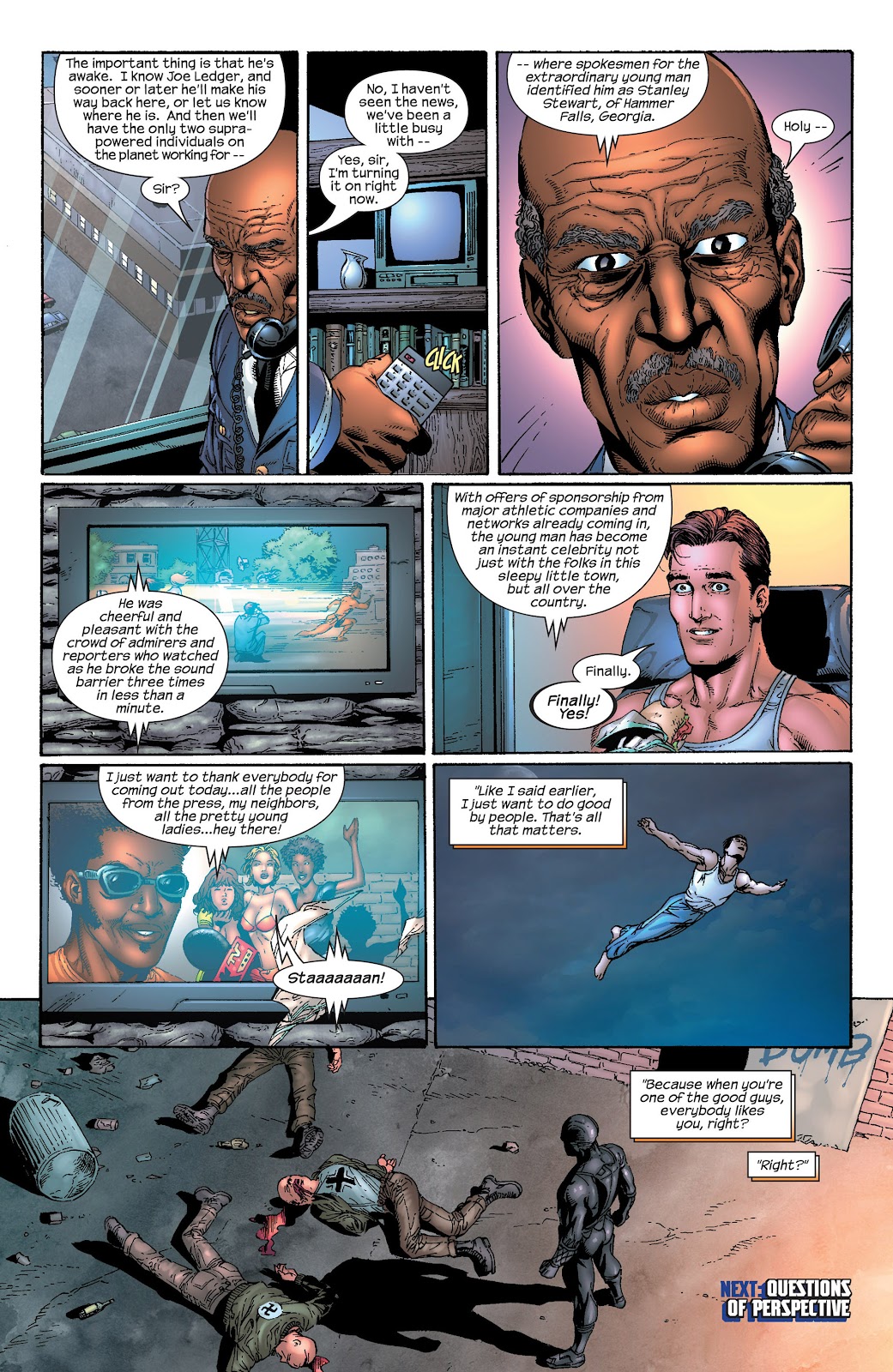 Thoughts: Thoughts: Starting to bring our super beings together. Mark is now on his own and feeling isolated, when he learns that Stan is ready to be known. Joe Ledger awakens, though whether or not he is in control is another question. Nighthawk stands over the bodies of neo-Nazis. His focus seems rather singular. The agents finding Stan, before the government seems a bit much, though we saw the government considered the Blur an urban legend; people trying to get in on the attention. Mark withheld his attempt to talk to Stan. Ledger is awakened by close proximity to the pod, for which the prism was the power source. There is talk of organic and inorganic matter bonding, when they examine Ledger, suggesting that the crystal is changing structure, while bonded to Ledger. JMS sends up the idea of Superman hiding behind glasses, though I prefer the Tick's version of the idea, in the Patrick Warburton series.  The reaction of the government men probably did even more to damage Mark's confidence in them and willingness to play ball. Gary Frank gives us an adult Stan, whose hair is kind of swept back, probably due to the running, at high speed. For at least some poses and facials, it appears as if he was using the younger Dwayne "The Rock" Johnson as a model. 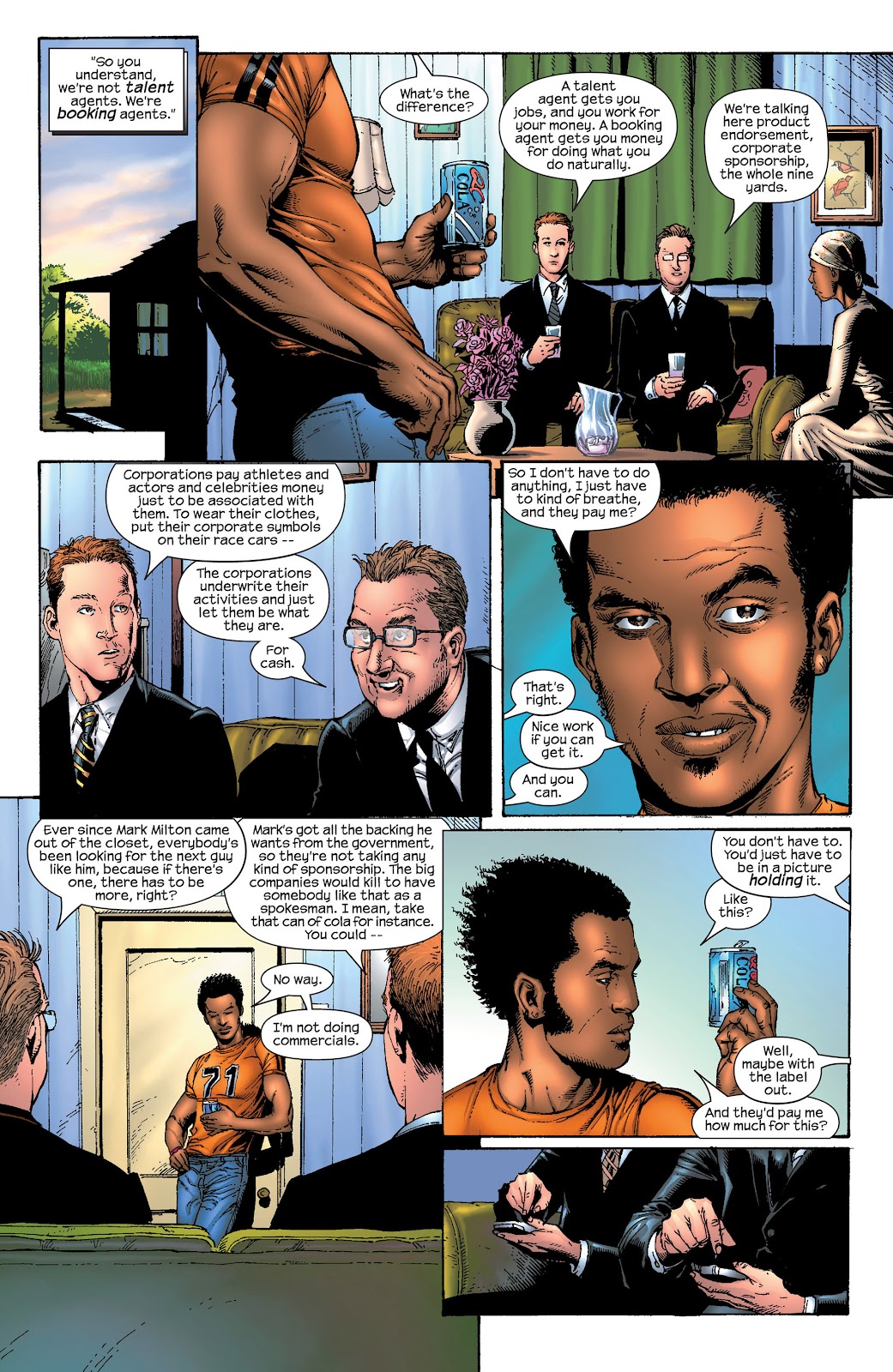  Johnson was red hot, around this time. Stan's public appearance upsets gen Casey's applecart, as they totally missed him and he is another X-factor. he already has doubts about Mark, based solely on his alien nature. the only one he is sure of is Ledger, which is why they are going to extremes to wake him, in case they need a weapon to bring down Hyperion. Sounds like foreshadowing. We only see Nighthawk at the end, standing over broken Nazis. JMS further cements the idea that he is going after white supremacists and thugs. We don't know if that is his sole focus, though that is a question that will come up, soon. Next, where the heck was Ledger going and is Hyperion flying off to find Stan?
|
|
|
|
Post by rberman on Mar 19, 2019 5:01:28 GMT -5
Supreme Power #5
My Two Cents: Mark Milton moves from the suburbs to the high rise. The shot of a hazmat team packing up his mom’s unmentionables mirrors a similar scene in Watchmen, as does the ironic voice-over describing the opposite of the images.  The tea kettle which Stanley’s mom used as a warning whistle was a smart touch, as was the discussion of how Blur learned not to win first place in races, and the reveal of the agents was a funny fake-out. The corporatization of super-powers would be widespread if they really existed. 
|
|
|
|
Post by codystarbuck on Mar 20, 2019 0:00:31 GMT -5
Supreme Power #6 Okay, we have enough for a trade; time for a fight! Creative Team: JMS and the rest of the alphabet. Synopsis: Stan's is at a press conference for the unveiling of his new, high tech suit.... 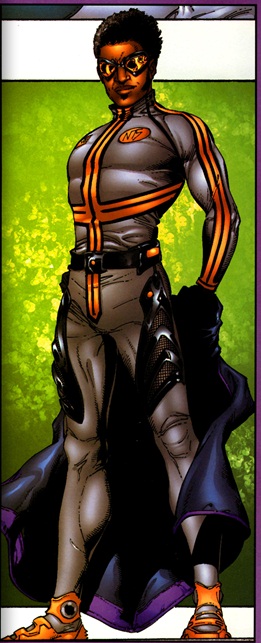 The vents are supposed to be related to venting heat; but, i think they would work better on the inside of the thighs, where the real heat buildup would originate. Hope is has something for chafing.... There is a gust of wind and a strange sound, which only Stan can fully see.... 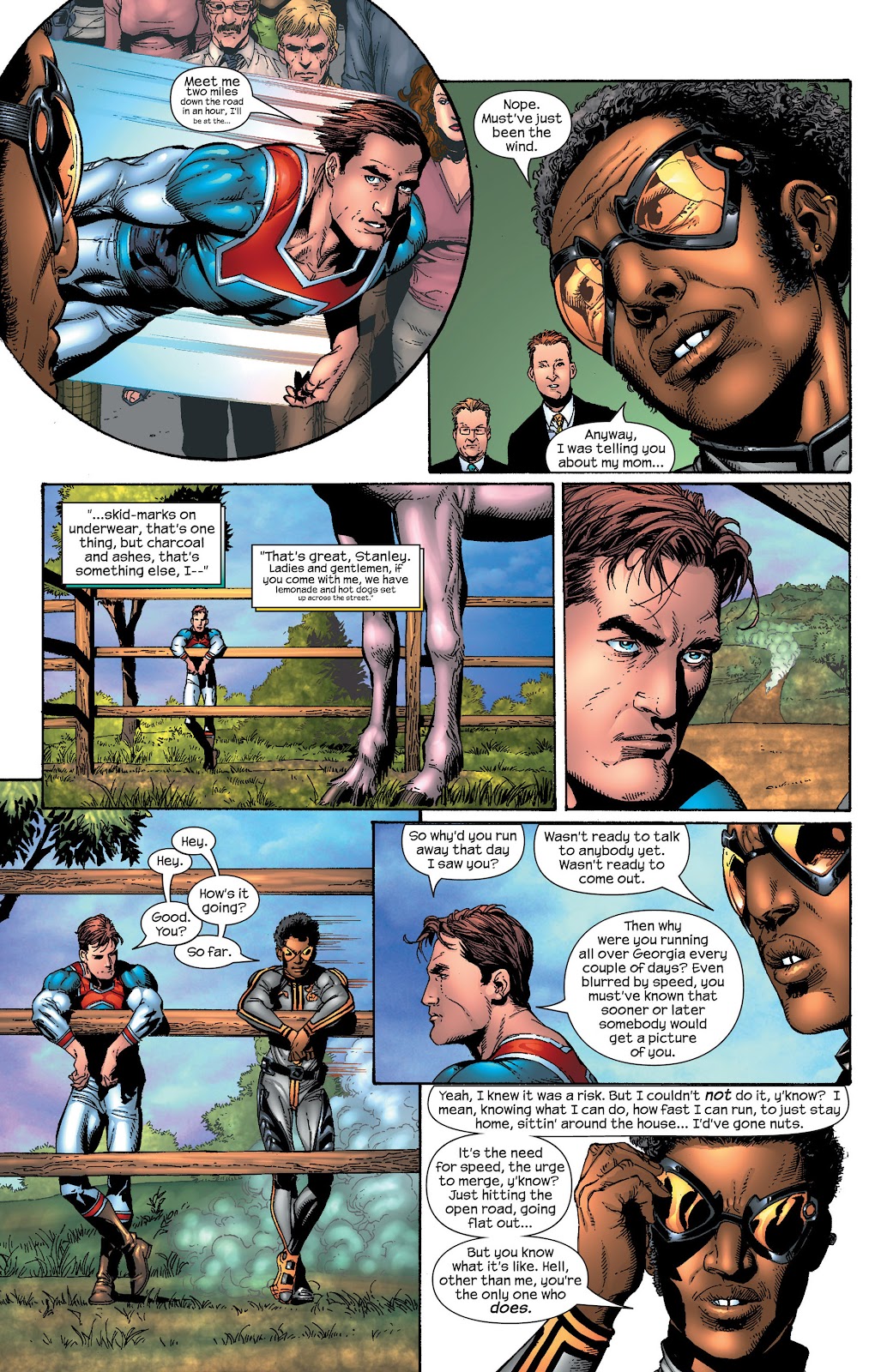 Stan and Mark meet up and Stan proceeds to talk like he stepped out of Days of Thunder. he and Mark share some questions and we get our first indication that Mark may have memories of the ship. We also see that when he first flew, he could reach space and look down upon the Earth... 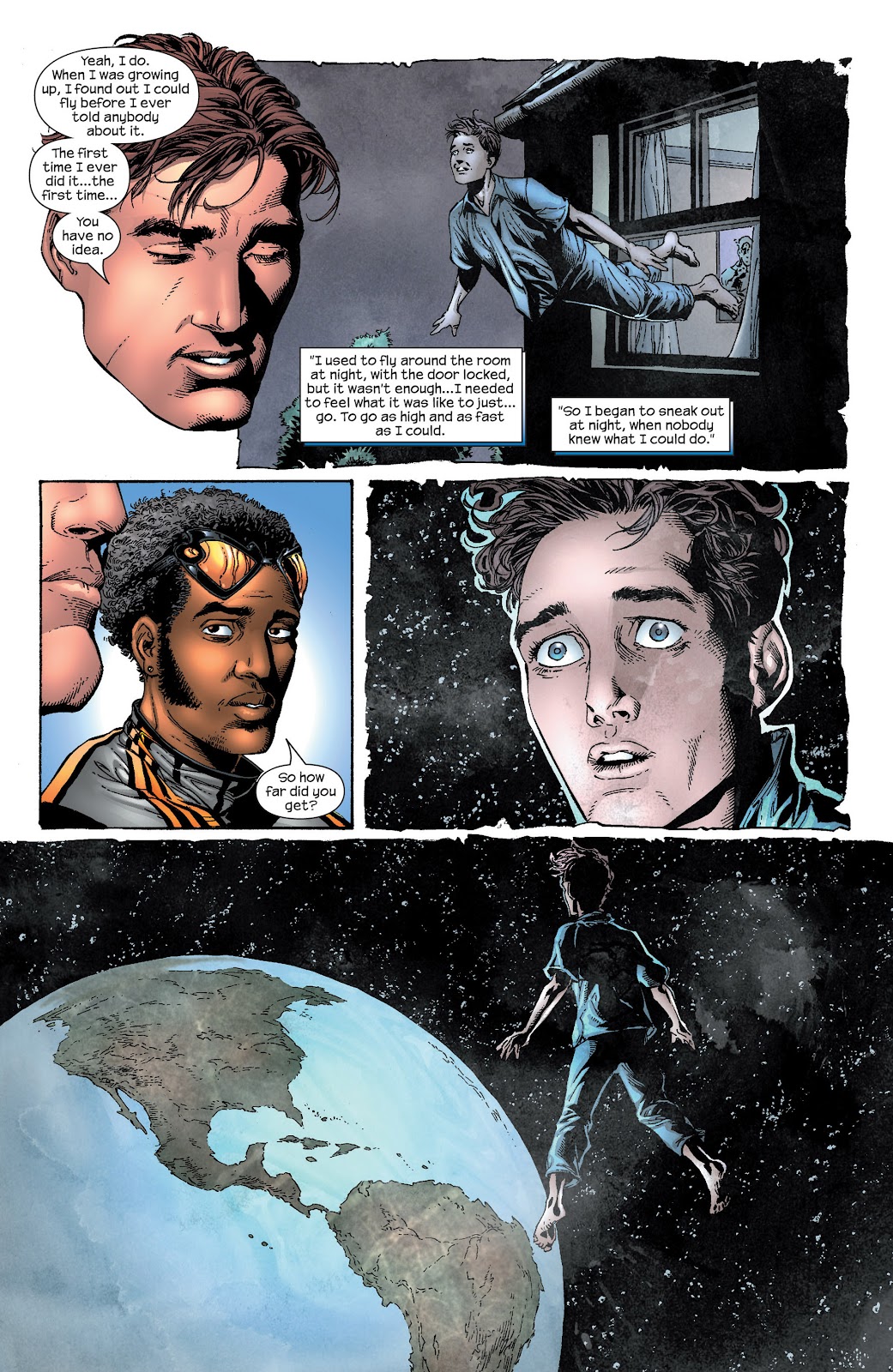 He didn't tell anyone and he doesn't tell Stan that he reached space. Stan tells him he needs goals to keep him occupied or it will drive him crazy, which could be dangerous. Mark heads off and Stan gives him a tip to check out Chicago, for another "urban legend." Meanwhile, a researcher, studying the pod, has discover ducts with 5 micron apertures, with nothing in them; but, something had been there. They contemplate the release of bacteria or viruses, or possibly nanotechnology. The implications are staggering and the head scientist speaks of how much bacteria constitutes an invasion? He goes home and meets up with Joe Ledger, whose a little agitated... 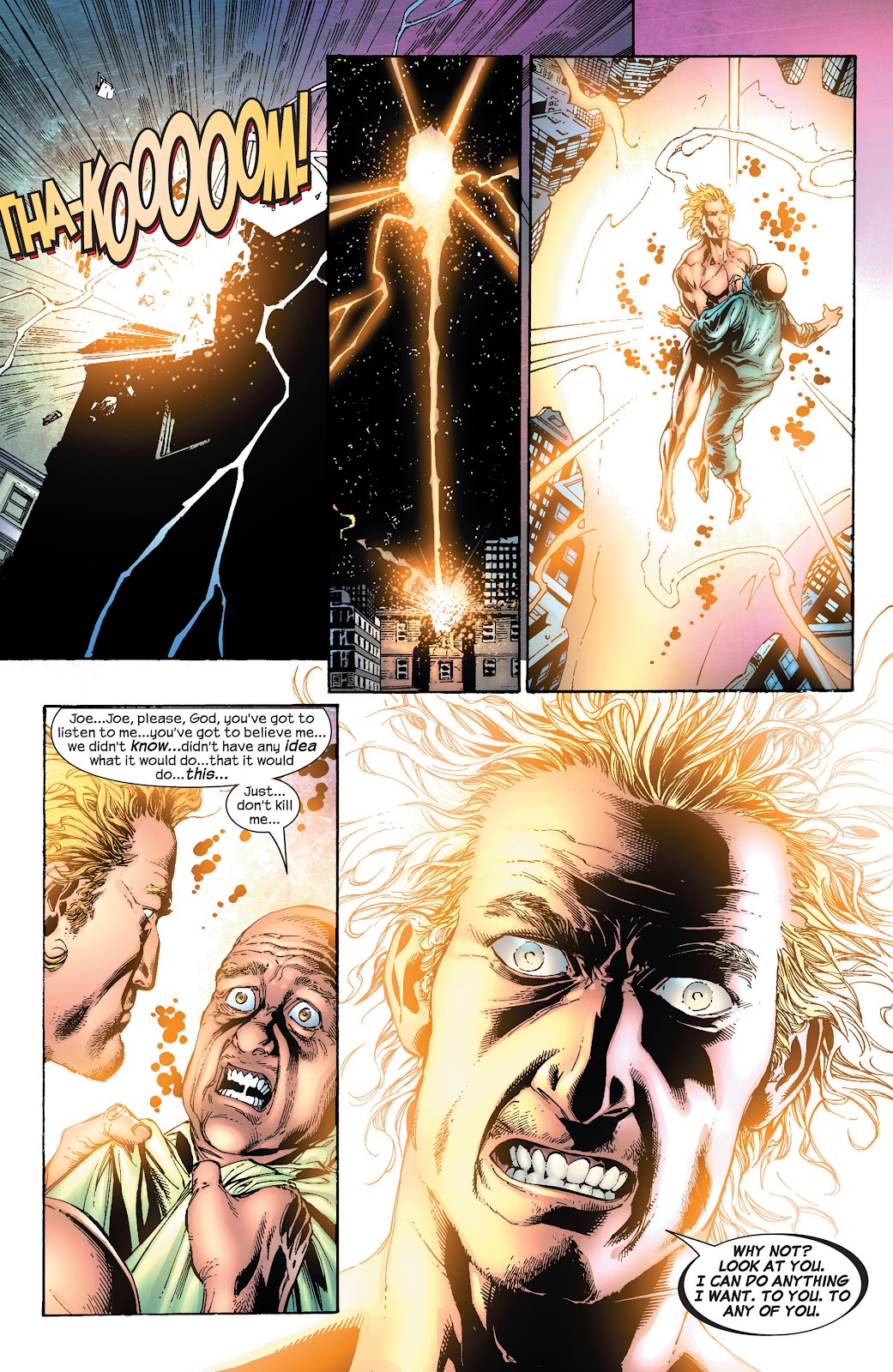 He suddenly calms down and starts talking like himself and returns to the research grounds. Later, the head scientist and the colleague, who found the ship openings discuss Ledger and the head dude wonders if he was talking to Ledger or the ship? Meanwhile, Mark goes to Chicago and meets up with nighthawk, as some punks are spraypainting racial slurs on a church. Mark introduces himself and proceeds to lecture Nighthawk. He notes observing the crimes Nighthawk did stop; but, also his failure to intervene in a white woman, chased by a Latino gang and an Asian grocery store owner harassed by street punks. He then goes into full morality mode..... 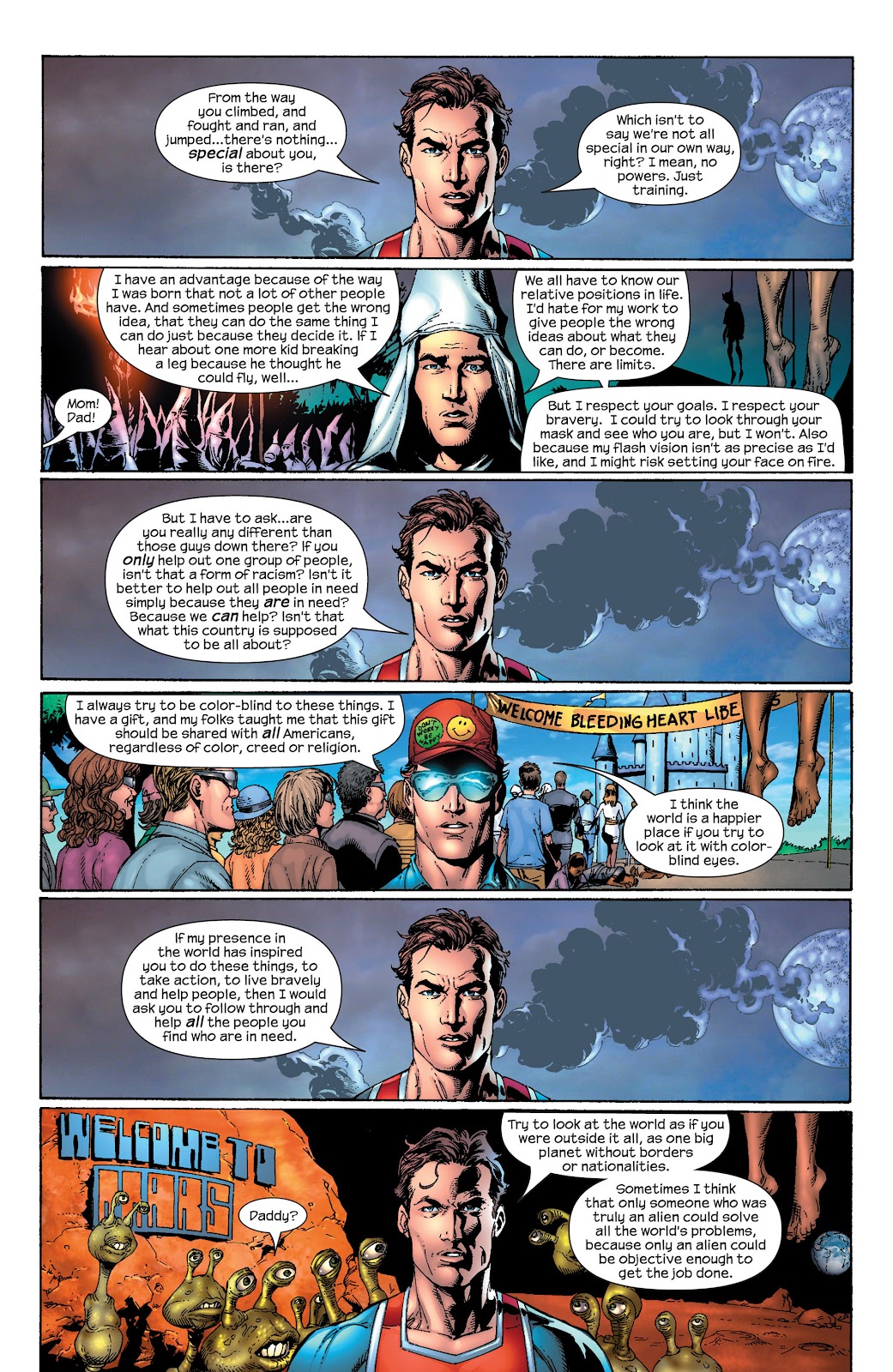 Nighthawk finishes the job, after Hyperion leaves him to it. We end with Mark staring back at the world, thinking of what he said to Nighthawk... 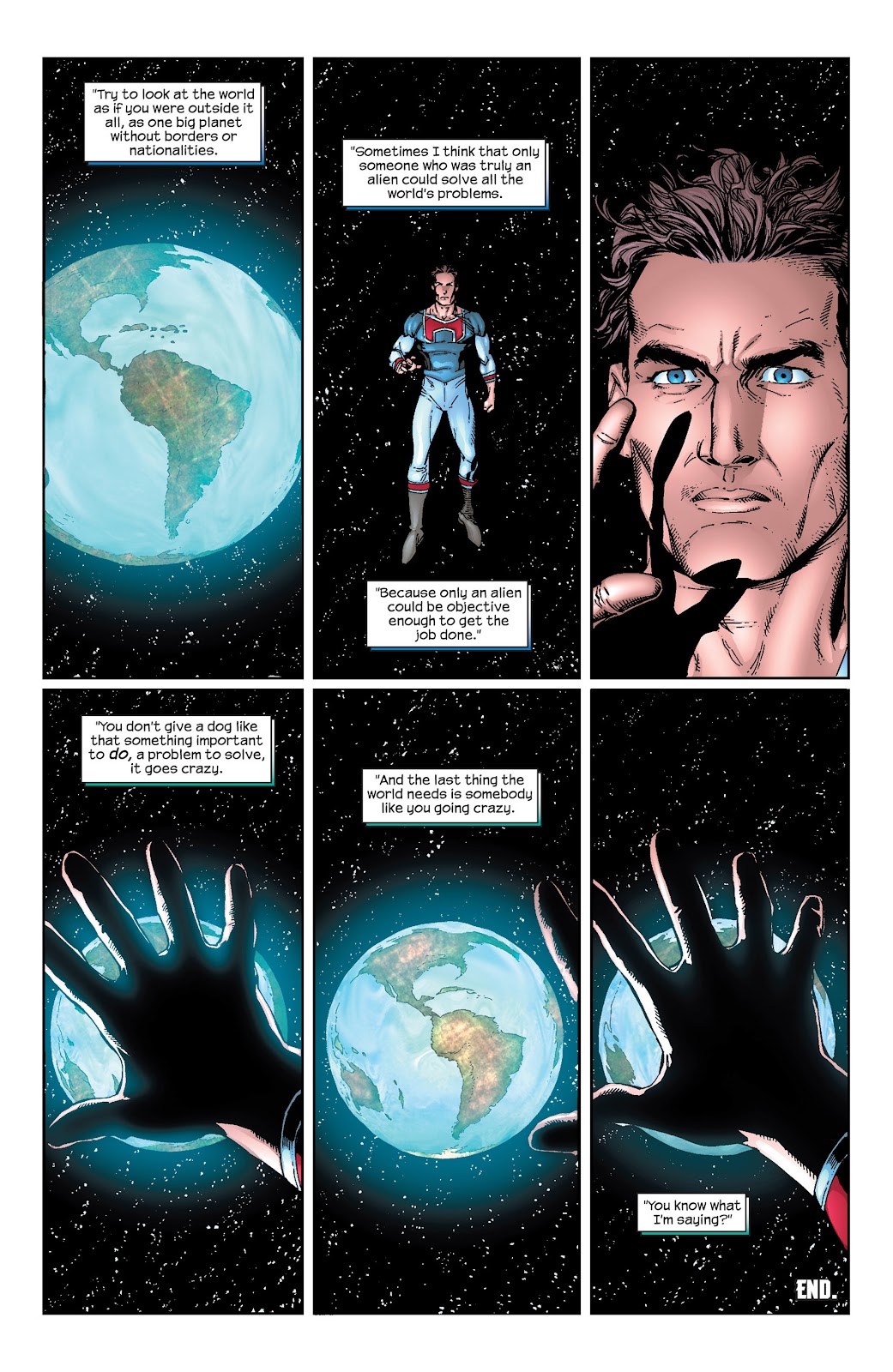 Thoughts: Thoughts: Wait, where's the fight? So, more bringing the players together, as Mark and Stan have a chat that gets Mark to thinking about what he could be doing, then a confrontation with Nighthawk, about what he should be doing. Both reflect aspects of Superman and the JLA. Mark and Stan are Clark and Barry, hanging out and swapping advice. Mark and Nighthawk are Clark and Bruce arguing over focus, though this goes beyond one city or a world; Nighthawk has been focusing on one people and Mark argues he should help all, because they need help. As the visual gags indicate, nighthawk thinks he is alternately racist, a pompous bleeding heart, or just plain nuts (or alien). In the end, he appears to see that Mark makes a good point, even if he thinks Mark is missing the grittier reality. This reflects more the post-Crisis Clark and Bruce, rather than the more congenial pre-Crisis friends. The scenes of Joe Ledger and the scientist look almost as if they copied them from Miracleman, Book 2, when MM confronted Dr Gargunza and held him aloft in space, demonstrating how terrible he could be. I've said before this has more in common with Miracleman than Watchman and I think that is demonstrated here, in Joe Ledger and in Hyperion, flying into space and looking down on the Earth, holding up his hands to blot it out, then closing his hand around the image of the planet. he truly sees beyond borders; but, what will he do with that perspective? Will he, as MM did, save the world from itself? So, we have a sort of closing to the opening chapter of this saga, though not entirely. We start to move on from here, though we will still have characters coming together. We have a ways to go before we have a Squadron. For now, we are still focused on the core, though the hand in the Mediterranean temple still doesn't have a face, to go with it. nor have we seen more of the child that survived in the water.
|
|